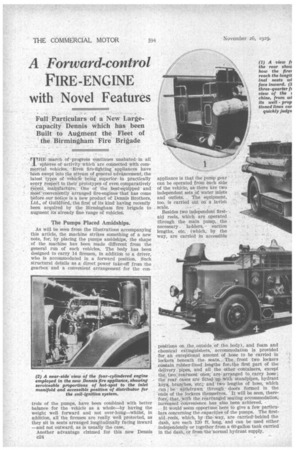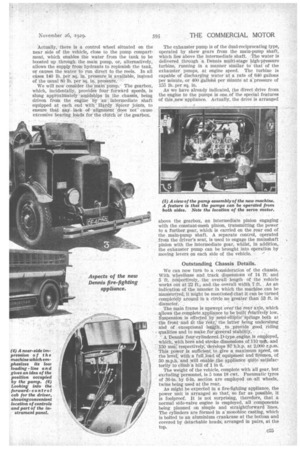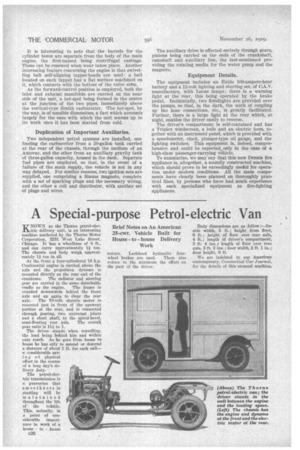A Forward-control
Page 62

Page 63

Page 64

If you've noticed an error in this article please click here to report it so we can fix it.
FIRE -ENGINE
with Novel Features
Full Particulars of a New Largecapacity Dennis which has been Built to Augment the Fleet of the Birmingham Fire Brigade IT HEmarch 'ofprogress •continues .unabated'. in all 'spheres of activity Which are connected' with:commercial Vehicles:.-.Everi fife-fighting appliances have been swept into the stream of general advancement the latest types of vehicle 'being. superior in practically every respeet.to their prototypes of even comparatively recent inahulfaeture. One of the best equipped • and Most' conveniently arranged fire-engines 'that has come before our notice is a new product of Dennis Brothers, Ltd., of Guildford, the first of its kind having recently been acquired by the Birmingham fire brigade to
augment its already fine range of vehicles. •
The Pumps Placed Amidships.
As will be seen frora the illustrations accompanying this article, the machine strikes something of a new note, for, by placing the pumps amidships, the shape of the machine has been made different from the general run of such •vehicles, The body has been designed to carry 14 firemen, in addition to a driver,' who is accommodated in a forward position. Such structural details as a direct power take-off from the gearbox' and a convenient arrangement for the con.
trols of the pumps, have been combined with better balance for the vehicle as a whole—by having the weight well forward and not over-hung--Whilst, in addition, all the firemen are really well protected, as they sit in seats arranged longitudinally facing inward —and not outward, as is usually the case.
Another advantage claimed for this new Dennis c24
appliance is that the pump gear can be operated from each side of the vehicle, as there are two independent sets of water inlets and outlets. The equipment, too, is carried out on a lavish scale.
Besides two independent firstaid reels, which are operated through the main pump, the necessary ladders, suction lengths, etc. (which, by the way, are carried in accessible
positions on ihez outside:of the. body), and foam and chemical eitinguishers; accommodation is provided for an exceptional amount of .hose to be carried in lockers beneath the. seats. ; The,. front two lockers contain rubber-lined lengths fork the first part of the delivery pipes, and all the other !containers, except the two rearmost: ones; are arranged to carry hose; the rear cases are fitted, uP with standpipes, hydrant keys, branches, 'etc:, and "two lengths of hose, which can j be withdrawn through doors formed in the ends of the lockers themselves. 'It will be seen, therefore; that with the rearranged seating accommodation, increased convenience , has'.alSo. been achieved. It would seem opportune. here to give a few particulars concerning the :capacities of the pumps. The firstaid reels, which, by the way, are carried! behind the dash, are each 120 ft. long, and can be used either independently or together from a 60-gallon tank carried in the dash,• or from -the'normal hydrant supply. Actually, there is a control wheel situated on the near side of the vehicle, close to the pump compartment, which enables the water from the tank to be boosted up through the main pump, or, alternatively, allows the supply from hydrants to replenish the tank, or causes the water to run direct to the reels. In all cases 140 lb. per sq. -in: pressure is available, instead of the usual 80 lb. per Sq. in. pressure.
We will now consider the main pump.' The gearbox, which, incidentally, provides four forward speeds, is slung approximately amidships in the chassis, being driven from the engine by an intermediate shaft• equipped at each end with Hardy Spicer joints, to ensure that any lack of 'alignment 'does notcause excessive bearing loads for the clutch or the gearbox.
The exhauster pump is of the dual-reciprocating type, operated by skew gears from the main-pump shaft, which lies above the intermediate shaft. The water is delivered through a Dennis multi-stage high-pressure turbine, running in a manner similar to that of the exhauster pumps, at engine speed. The turbine is capable of discharging water at a rate of 840 gallons per minute, or 400 gallonS per Minute at n'pressure of 155 lb. per sq. in.
• As we have already indicated, the direct drive from the engine to the Pumps is one. of the special features of this new appliance. Actually, the drive is arranged above the gearbox, an intermediate pinion engaging with the constant-mesh pinion, transmitting the power to a further gear, which is carried on the rear end of the main-pump shaft. A separate control, operated from the driver's seat, is used to engage the rnainshaft pinion with the intermediate gear, whilst, in addition, the exhauster pump can be brought into operation by moving levers on each side of the vehicle. -""
Outstanding Chassis Details.
We can now turn to a consideration of the chassis. With wheelbase and track dimensions Of 14 ft: and 5 ft. reSfoectively,. the' overall length of. the .vehicle works out at 22 ft.; and the .overall width 7 ft. As an indication of the manser. in Which the machine ,can be manieuvred, it might be nientioned,that it can be turned completely around in a circle no greater " tlian 53 ft. in'
diameter. _ . : The main frame is upswept over the rear axle, which 0,1lows the complete appliance to be built l'elatively low. Suspension is effeqed by ,seMi-elliPtie'Springs both at the front and at the "rear; the latter being underslung and of exceptional length, , to ,provide good riding qualities and to make for general stability.
A Dennis four-cylindered, D-type engine is employed, which, with. bore and stroke dimensions of 116 tmfl, and 150 mni; respectively', TieVelops 87-b.h.p. at 2,000 r.p.m. This power is sufficient to give a maximum speed, on the level; with a full load of equipment and firemen, of 50 m.p.h. and will enable the appliance qinte.satisfac
torily to climb n hill of 1 in 6.
The weight of the vehicle, complete with all gear, but excluding personnel, is 5 tons 18 cwt. Pneumatic tyres of 38-in. by 6-in. section are employed on n11 wheels, twins being used at the rear.
As might be expected in a fire-fighting appliance, the power unit is arranged so that, so far as possible, it is foolproof. It is not surprising, therefore, that a normal side-valve engine is employed, all components being planned on simple and straightforward lines. The cylinders are formed in a monobloc casting, which is bolted to an aluminium crankcase at the bottom and covered by detachable heads, arranged in pairs, at the
• It is interesting to note that the barrels for the cylinder bores are separate from the body of the main engine, the first-named being centrifugal castings. These can be renewed when wear takes place. Another interesting feature concerning the engine is that swivelling ball self-aligning tappet-heads are used : a ball located on each tappet has a flat surface machined on it, which contacts with the bottom of the valve stem. As the forward-control position is employed, both the inlet and exhaust manifolds are carried on the near side of the unit, a hot-spot being formed in the centre at the junction of the two pipes, immediately above the vertical-type Zenith carburetter. The hot-spot, by the way, is of sensible dimensions, a fact which accounts largely for the ease with which the unit warms up to its work once it has been started from cold.
Duplication of Important Auxiliaries.
Two independent petrol systems are instated, one feeding the carburetter from a 20-gallon tank carried at the rear of the chassis, through the medium of an Autovac, and the other from an auxiliary gravity tank of three-gallon capacity, housed in the dash. Separate fuel pipes are employed, so that, in the event of a failure of the main supply, the vehicle is not in any • way delayed. For similar reasons, two ignition sets are supplied, one comprising a Simms magneto, complete with a set of sparking plugs and the necessary wiring, and the other a coil and distributor, with another set of plugs and wires. The auxiliary drive is effected entirely through gears, pinions being carried on the ends of the crankshaft, camshaft and auxiliary line, the last-mentioned providing the rotating media for the water pump and the magneto.
Equipment Details.
The equipment includes an Exide 100-ampere-hour battery and a 12-volt-lighting and starting set, of C.A.V. manufacture, with Lucas lamps ; there is a warning light at the rear, this being operated by the brake pedal. Incidentally, two floodlights are provided over the pumps, so that, in the dark, the work of coupling up the hose connections, etc., is greatly facilitated. Further, there is a large light at the rear which, at night, enables the driver easily to reverse.
The driver's compartment is self-contained and has a Triplex windscreen, a bulb and an electric horn, together with an instrument panel, which is provided with a speedometer, clock, plunger-type oil gauge, and the lighting switches. This equipment is, indeed, comprehensive and could be expected,only in the ease of a high-class 'passenger-carrying vehicle.
To summarize, we may say that this new Dennis fire appliance is, altogether, a soundly constructed machine, which should prove to be exceedingly useful for operation under modern conditions. All the main components have clearly been planned on thoroughly practical lines, by persons who have had much experience with such specialized equipment as fire-fighting appliances.




























































































































